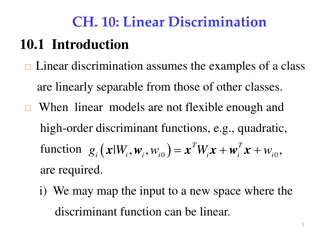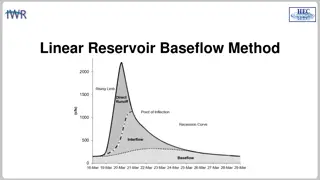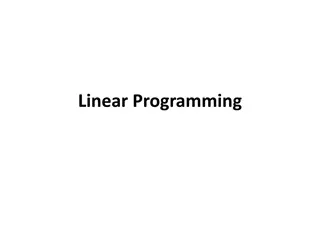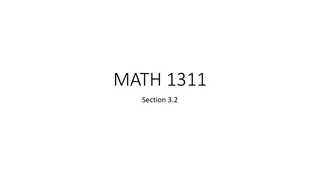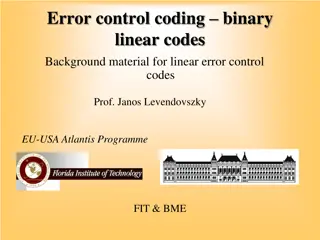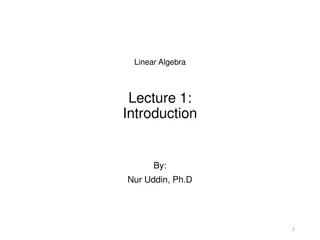Linear Independence and Wronskians: Fall 2023 Notes
Definition and examples of linear independence, including conditions for functions to be linearly independent or dependent on specific intervals. Discusses linear dependence and examples to illustrate concepts related to linear independence.
Download Presentation

Please find below an Image/Link to download the presentation.
The content on the website is provided AS IS for your information and personal use only. It may not be sold, licensed, or shared on other websites without obtaining consent from the author.If you encounter any issues during the download, it is possible that the publisher has removed the file from their server.
You are allowed to download the files provided on this website for personal or commercial use, subject to the condition that they are used lawfully. All files are the property of their respective owners.
The content on the website is provided AS IS for your information and personal use only. It may not be sold, licensed, or shared on other websites without obtaining consent from the author.
E N D
Presentation Transcript
1 2 N ECE 6382 1 2 N = ( ) W x ( 1) ( 1) ( N 1) N N N 1 2 Fall 2023 David R. Jackson Notes 17 Linear Independence and Wronskians Notes are from D. R. Wilton, Dept. of ECE 1
Linear Independence Definition: ( ) of the real axis if the only solution to the set of homogeneous equati = A set of functions , linearly independent is on an interval ons ( ) x 1,2, , , n N a b n N ( ) n n c ( ) x 0 x identically qua l to zero; i.e., equal to zero for all in the interval = 1 n = is 0, . c n n A set of functions that is not linearly independent is said to be linearly dependent. Important point: The interval is important here. Functions can be independent in one region (interval) and dependent in another region. 2
Linear Independence (cont.) Assume linear dependence: N ( ) ( ) n n c ( ) x 0 , 0 c in a region not all coefficients are zero n = 1 n p c 0 Assume c c c c c c c c + 1 1 p p = Then N 1 2 + 1 2 1 1 p p p N c c p p p p p = 1 1 a + 2 2 a + 1 + 1 + + or a a a + 1 1 p p p p p N N Conclusion: If a set of functions is linearly dependent, then at least one of the functions can be written as a combination of the others. 3
Linear Independence (cont.) Assume one function can be written as a combination of the others: = 1 1 a + 2 2 + + + 1 + + + a a a a + 1 1 p p p p p N N (for all x in an interval) Then ( ) 1 1 a + 2 2 + + + 1 + + + = 1 0 a a a a + 1 1 p p p p p N N = 1 0 . c c n p n Conclusion: If one function can be written as a combination of the others, then the functions are linearly dependent. 4
Linear Independence (cont.) Linear dependence At least one of the functions can be written as a combination of the others. Note: When there are only two functions, linear dependence means that one function is a constant times the other one. 5
Linear Independence (cont.) Examples are linearly independent are linearly independent (sin ,cos ) ( , , x x x x x 2 3 ) + 2 2 are linearly dependent ( , x x x , 2 ) x ( + ) = + 2 2 1/ 2 2 1/ 2 x x x x ( x ) 1 = + + 2 2 2 2 x x x x 1 + = + 2 2 2 2 x x x 2 2 are linearly dependent 0 5 x x x = + ( , x x ,5 ) x 5 = + 2 2 0 5 1/5 x x x Note that we cannot write x as a combination of the other two functions. 2 2 6
Linear Independence (cont.) Note: The classification of linear independence depends on the interval for x that is being considered. Example: 1, 0 x ( ) f x cos , 0 x x 2, + 0 x ( ) g x 2, 0 x x These two functions are linearly independent on any interval (a, b) that contains positive x values. These two functions are linearly dependent on any interval that contains only negative x values. 7
Wronskians and Linear Independence The Wronskian allows us to test for linear independence on some interval. 1 2 1 2 N N 1 2 1 2 N N = ( ) det W x ( 1) ( 1) ( N 1) ( 1) ( 1) ( N 1) N N N N N N 1 2 1 2 We look at whether or not the Wronskian vanishes identically over an interval. Josef Ho n -Wronski Note: The fact that the Wronskian vanishes at some points does not tell us anything useful. 8
Wronskians and Linear Independence (cont.) Assume linear dependence : = 1 1 a + 2 2 + 1 + 1 + + For so e value of m : p a a a a (for all x in an interval) + 1 1 p p p p p N N Then, taking up to derivative s, we have: -1 N + + + = = = + + + 2 2 1 + + + 1 + + + + + 1 1 a a a a a a + + 1 1 p p p p p N N a a a a + 1 1 a 2 2 1 1 1 1 p p p p p N N a a a a + 1 1 2 2 1 1 1 1 p p p p p N ( p ) ( ) ( ) ( p ) ( p ) ( N ) 1 1 1 1 1 1 N N N N N + N = 1 1 a + 2 2 + 1 + 1 + + a a a a 1 1 p p N The so the column of the Wronskian matrix is thus a combination of the other columns, determiant is zero (from linear algrebra). pth 1 2 N W x = 1 2 N + + = = ( ) ( ) ( ) ( ) 0 a W x a W x W x 1 1 2 2 p ( 1) ( 1) ( N 1) N N N 1 2 th p column vector ( ) Linear dependence 0 W x Hence 9
Wronskians and Linear Independence (cont.) Interestingly, 2 x ( ) Linear dependence 0 W x x x x (Peano): Example ( ) 2 , x x x ( ) but we have linear independence that includes the origin! 0, W x on any interval ( , ) a b However, if the functions are linear dependence (proof by Peano). analytic (with ), then x z ( ) x 0 W Giuseppe Peano ( ) ( ) 0 ( ) 0 ( ) 0 ( ) 0 ( ) 0 1 2 = = = = Note: 0 0, 0 W 1 2 10
Wronskians and Linear Independence (cont.) Summary For arbitrary functions: ( ) Linear dependence 0 W x For analytic functions: ( ) Linear dependence 0 W x ( ) W x Note: For arbitraary functions: Linear independence 0 (This is the converse of the first statement.) 11
Wronskians and Linear Independence (cont.) Wronskian Flowchart The Wronskian is used to determine if a set of functions is linearly independent or not on a given interval. Calculate Wronskian Yes No Is Wronskian identically zero on interval? Linearly independent Yes No Are functions analytic? Linearly dependent Inconclusive 12
Wronskians and Linear Independence (cont.) Note on Analytic Functions ( ) Linear dependence 0 W x This is logically equivalent to: ( ) Linear independence 0 W x Hence, for analytic functions we have: ( ) ( ) W x 0 independence 0 W x dependence 13
Wronskians and Linear Independence (cont.) Example = = = ikx ikx Show that are linearly dependent . ( ) x , ( ) x , ( ) x sin e e kx 1 2 3 Note: The three functions are analytic. Note: (a,b) is arbitrary here. ikx ikx sin cos k k e e ike k e kx kx 1 2 3 = ikx ikx ike k e 1 2 3 2 2 2 ikx ikx sin kx 1 2 3 ( ) 2 Last row is first row Obervation: k The determinant is identically zero. Note: Linear dependence The three functions are analytic, so W 0 is equivalent to linear dependence. 14
Wronskians and Linear Independence (cont.) Example Show that any of these four functions are pair linearly independent : = = = = ikx ikx ( ) x , ( ) x , ( ) x sin , ( ) x cos e e kx kx 1 2 3 4 Note: (a,b) is arbitrary here. Illustrate using 1, 3: ikx sin cos k e kx kx 1 3 = = ikx ikx cos sin ke kx ike kx ikx ike 1 3 ( ) ( ) 1 3 = = = ikx ikx ikx cos sin ke kx i kx ke e k 1 3 ( ) 1 3 0 anywhere Linear independence on any interval 1 3 Note: These functions are analytic, but here the conclusion does not depend on this. 15
Wronskians for SOLDE*s Assume are two solutions of ( ), ( ) y x y x 1 2 = + y + = Ly ( ) p x y ( ) q x y 0 y y *SOLDE: Second-Order Linear Differential Equation We have: y y y y 2 1 1 2 = = ( ) W x y y y y 1 2 1 + 2 1 ( p y y 2 1 = W y y y y y y ) ) 1 y y 2 1 2 1 2 ( pW ) 2 1 = ( y py qy y py qy 1 2 2 1 2 = = = y y 1 2 W W ( ) p x Also, we have = W W d dx ( ) ( ) ln ( ) W x from the chain rule Hence d dx ( ) = ln ( ) ( ) p x W x 16
Wronskians for SOLDEs (cont.) d dx ( ) = From the last slide: ln ( ) ( ) p x W x = = Integrate from to : ( ) x a x x a is arbitrary x ( ) ( ) W x W a = = ln ( ) ln W x ( ) ln ( ) p x dx W a a x ( ) p x dx = a ( ) ( ) W x W a e 0 = x W a ( no The Wronskian either vanishes for all x W a ( ) or f or )! ( ) 0 ( ) 0 ( ) ( ) W x 0 independence Recall: If the functions are analytic: 0 W x dependence Conclusion: If the two solutions to a SOLDE are analytic, then they must be either linearly dependent or linearly independent everywhere on the x axis. 17
Wronskians for SOLDEs (cont.) Example: ( ) x ( ) + = 2 0 y k y x General solution: ( ) y x ( ) ( ) = + sin cos A kx B kx (analytic functions) ( ) ( ) x ( ) ( ) ( ) x ( ) = = = = 3sin x kx sin x kx 1 1 ( ) ( ) 10sin kx cos kx 2 2 Linearly dependent everywhere Linearly independent everywhere 18


